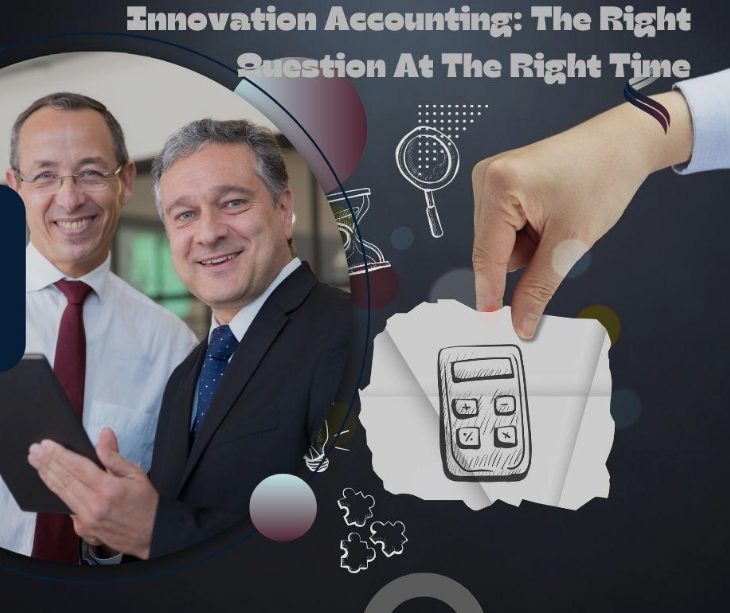Table Of Contents
- What Is Innovation Accounting, And Why Does It Matter?
- Gaining Validated Learnings
- Emphasize Revenues
- When To Ask The Right Questions
- 2. Experimentation Stage
- 3. Execution Stage
- Real-World Examples
- Implementing Innovation Accounting
- Innovation Accounting In Action
- Innovation Accounting Helps Identify The Right Innovation Questions
- Making Innovation Accounting Work
- Key Takeaways
- Conclusion
- FAQs
Innovation Accounting: The Right Question At The Right Time
Last Updated on: November 14th, 2024
Trying to grow your business through innovation? There’s a smart way towards growth called innovation accounting. Forget about traditional accounting. Innovation accounting helps you focus on the right metrics to grow your business.
In this article, I’ll explain how to use innovation accounting to ask the right questions at the right time. However, you’ll learn simple frameworks to test your ideas, understand what customers want, and invest where it matters most. Hence, no more wasted time and effort. Just a smarter approach to innovation that drives real results.
Sound useful? Keep reading, and I’ll walk you through everything step-by-step. Together, we’ll get you asking the right questions to build products people love. Keep reading to uncover the power of Innovation Accounting.
What Is Innovation Accounting, And Why Does It Matter?
Innovation accounting is like financial accounting but for innovation projects. Moreover, it gives you a framework to track progress, measure results, and collect data. However, the goal is to get insights to make smarter decisions. The metrics and data help you understand what’s working so you can double down on it.
They also show what’s not working so you can change course. With innovation accounting, you don’t rely on gut instinct. You use hard numbers and evidence to guide your innovation efforts.
This prevents wasted time and money on ideas that don’t pan out. However, the key is asking the right questions at each stage so you get the data you need. This article will explain how to do innovation accounting step-by-step. With the right insights, you can create products and services customers truly value.
Gaining Validated Learnings
The key questions innovation accounting aims to answer include whether we are gaining validated learnings, reducing uncertainty, and can pivot to improve. Addressing these questions is why innovation accounting matters. But what is innovation accounting, more specifically? It is a structured approach to tracking innovation efforts using metrics and data.
Emphasize Revenues
Unlike traditional financial accounting models, which emphasize revenues, costs, and profitability, innovation accounting zooms in on learning, uncertainty reduction, and continuous improvement. However, the key questions it aims to answer include:
- Are we gaining validated learnings and insights from our innovation efforts?
- How much have we reduced uncertainty around our value proposition and product-market fit?
- How can we use these learnings to pivot and improve our approach?
Thus, by enabling evidence-based decisions grounded in data instead of intuition, innovation accounting allows businesses to pivot and enhance their innovation strategy. It provides a data-driven compass for innovation success.
Some core principles of an effective innovation accounting framework include:
- Accelerating the pace of experimentation and learning.
- Tight feedback loops to continuously collect customer data.
- Letting data guide choices to persevere or pivot.
- Custom metrics to track meaningful progress indicators.
In summary, innovation accounting matters because it drives strategic, measurable innovation that delivers real results. The insights it provides allow companies to systematically advance innovation efforts.
When To Ask The Right Questions
Innovation initiatives progress through several distinct stages as they move from ideas to scale. Asking the right questions at each phase of the innovation lifecycle is key to guiding decisions and strategy.
Ideation Stage
During the ideation phase, where ideas are shaped into potential offerings, key questions include:
- What specific customer problem are we trying to solve?
- Who represents the target customer segment for this innovation?
- How big is the addressable market opportunity?
Thus, getting clarity on these questions helps properly define the opportunity and validate whether there is a real customer need that the innovation can potentially fill.
2. Experimentation Stage
In the experimentation stage, when prototypes and MVPs are developed, important questions include:
- What is the fastest and most insightful experiment we can run to test our assumptions?
- What 1-2 metrics will indicate genuine customer interest and product potential?
- How can we quickly tweak and iterate on the offering to improve these key metrics?
Rapid experimentation and user feedback at this stage guide effective product design.
3. Execution Stage
Finally, in the execution stage, when scaling the innovation, critical questions are:
- Are our innovation accounting metrics trending upward as expected?
- Where should we double down our efforts, resources, and energy to fuel growth?
- What indicators signal that we should quit certain experiments or even change course more fundamentally
Thus, the innovation accounting framework steers smart scale-up decisions using data.
Real-World Examples
Successful companies use innovation accounting to make better innovation decisions:
- Netflix tests multiple pilots, analyzes viewer data, and invests in those with the highest potential. However, they are laser-focused on engagement metrics.
- Airbnb tested its offering in a small market, tracked usage and reviews, and expanded to high-interest locations. Moreover, they optimized based on key metrics.
- Slack built a minimum chat app, put it out for teams to try, and saw explosive organic growth. Moreover, they doubled down on the momentum.
Implementing Innovation Accounting
Implementing innovation accounting requires focusing on a few key best practices:
- Define a set of innovation key performance indicators (KPIs) that go beyond vanity metrics to provide actionable insights into customer interest and product potential. These could include customer acquisition costs, retention rates, referral rates, and customer lifetime value.
- Rapidly devise small experiments and minimum viable products (MVPs) to test assumptions and generate learnings about the product and market.
- Now, build in feedback loops to continuously collect both qualitative and quantitative data from experiments through surveys, interviews, analytics, etc.
- Objectively analyze the results and metrics from experiments at fixed intervals, whether weekly or monthly. Use the data to determine the next steps – double down on what shows promise, pivot by changing direction, or kill initiatives that aren’t gaining traction.
- Maintain a sense of speed and urgency throughout the process, rapidly moving from ideas to building MVPs to scaling up initiatives that are successful. The velocity of learning and iteration is key.
- Visually track KPIs on data dashboards that provide real-time visibility into how innovation metrics are trending.
- Take a learn, adjust, and repeat approach to continually refine offerings based on customer feedback and data from experiments. Be flexible and adapt offerings to optimize performance.
Innovation Accounting In Action
The example of online retailer Bonobos highlights how innovation accounting can work as part of a lean startup approach in practical terms:
- First, they defined their target customer – young professionals in cities who want great-fitting pants.
- Next, they ran a small experiment – setting up a basic website to sell pants online. They tracked key numbers like sales and product returns.
- The sales and customer feedback were strong, so Bonobos expanded quickly to new pants styles and colors.
- Finally, they kept iterating. Customers wanted more sizes and tops. So Bonobos added new items like shirts and suits.
- By constantly testing and tracking data, Bonobos could make smart choices. They scaled fast by giving customers what they wanted.
That’s innovation accounting in action. Run small tests, watch the metrics, then build on what works. Bonobos used data to create products people love. You can do the same by asking the right questions.
Innovation Accounting Helps Identify The Right Innovation Questions
The key questions that innovation accounting helps uncover at each stage of the innovation process can be summarized as:
| Innovation Stage | Key Questions |
| Ideation |
|
| Experimentation |
|
| Execution |
|
This table summarizes how innovation accounting points to the right questions during key stages of innovation. The framework helps companies learn, adapt, and make evidence-based decisions.
Making Innovation Accounting Work
While innovation accounting is a proven methodology, avoid potential pitfalls:
- Don’t over-analyze metrics. Focus on the big-picture trends.
- Beware of false positives. Seek more data before making big investment decisions.
- Don’t rely on vanity metrics like web traffic. Focus on actionable metrics.
- Avoid analysis paralysis. Balance data-driven decisions with speed and agility.
Key Takeaways
Some of the main takeaways on implementing an effective innovation accounting approach include:
- Innovation accounting helps shift companies from intuition-based to fact-based innovation through rigorous measurement.
- Moreover, the framework identifies the right questions to ask at each phase of innovation, from ideation to experimentation to execution.
- Critical innovation metrics go beyond vanity metrics to provide actionable insights into customer behavior and product experience.
- The rapid prototyping and experimentation are essential to test assumptions and collect learning quickly
- Ongoing build-measure-learn feedback loops help guide decisions to pivot or persevere.
- Balance being data-driven with speed and agility when innovating. Avoid over-analysis.
- Consistent tracking and monitoring of metrics provides visibility into what’s working.
- Innovation accounting enables a culture of evidence-based decisions and continuous improvement powered by customer data.
- Companies like Netflix, Airbnb, Slack, and Bonobos demonstrate real-world success with the methodology.
Conclusion
Asking the right questions drives growth. With innovation accounting, you learn what works and double down on it. You see what doesn’t and change course quickly. No more building products people don’t want. Just useful data to create real value.
Start small, track results, iterate, and scale. Take the guesswork out of innovation. Focus on meaningful metrics to build what customers crave. That’s how innovation accounting leads to innovation success.
FAQs
1. What are some key innovation accounting metrics?
Beyond vanity metrics, focus on actionable metrics like customer acquisition cost, churn rate, referral rate, and customer lifetime value. These provide insights into customer behaviors.
2. How can innovation accounting work for large companies?
Take a venture capital approach with incubators and internal startups. Provide dedicated resources and track metrics separately from core business units.
3. How to get stakeholder buy-in for innovation accounting?
Showcase examples of data-driven successes. Start small and demonstrate results. Structure incentives around innovation KPIs.
Read Also:














